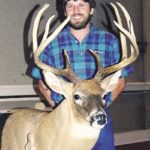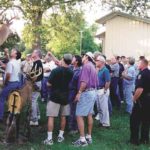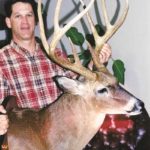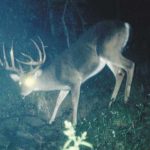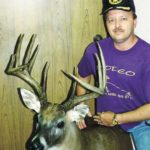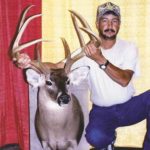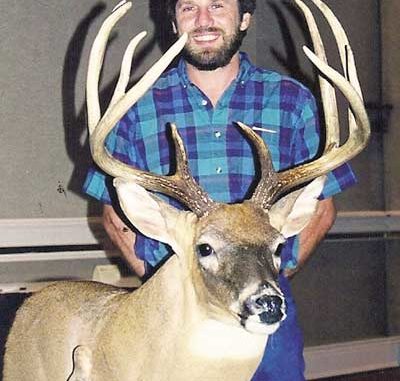
While most hunters dream of bagging a true Booner, the reality is, your chances are slim. But there are some areas in Louisiana where dreams can come true.
Fair Chase is the official publication of the Boone and Crockett Club. In the magazine is a section containing all the trophies that have been officially measured and accepted for the All-Time Record Book and the 27th Big Game Awards Program, 2007-2009. The Fall 2008 issue lists in the Non-Typical Whitetail Deer Category a deer killed by Christopher G. Campbell Jr. As reported in Louisiana Sportsman, Chris killed a 203 5/8 B&C non-typical in Caddo Parish last hunting season. It is the new state record for the Muzzleloader Non-Typical Category. It was also the only deer listed from Louisiana in that issue of Fair Chase.
Other southeastern states that had deer in that issue included Kentucky (20 deer), Mississippi (seven deer), Missouri (15 deer), Texas (six deer) and North Carolina (one deer). There were no deer from Alabama, Arkansas, Georgia or any of the other remaining southeastern states.
Table 1 shows the top B&C bucks from the southeastern United States. As you can see, the scores of the deer from Louisiana compare favorably with the top deer from other states in the Southeast.
In general, Boone and Crockett class deer are not common in the Bayou State. There might be two or three killed each season. The Annual Deer Harvest Survey estimates about 125,000 bucks (plus or minus a few thousand) killed annually. Hopefully the new deer tagging program will provide a more detailed picture of the annual harvest.
Do the math and it is evident that the chances of any one hunter killing a B&C buck are not real good. But that doesn’t mean you need to book that out-of-state hunt. Your chances of killing one in another state are not that good either.
There are some states that are producing B&C trophies on a more regular basis. Bill Winke wrote an article in that same issue of Fair Chase about the states where a hunter may have the best opportunity to bag one. Iowa, Wisconsin, Illinois, Indiana and Kentucky are his top-five choices. The remainder of his top-10 list included Saskatchewan, Ohio, Missouri, Minnesota and Kansas. Kentucky is the only southeastern state in his top five; maybe the one-buck limit is working.
Boone and Crockett is by far the standard for judging and ranking white-tailed deer. The scoring system is based upon symmetry, with the antler material (beams and points) on the right side being similar in length and appearance to the left side.
Deductions are taken for lack of symmetry, and this is the reason many complain about the scoring system. Because of this, other organizations have developed different scoring systems to measure and rank deer. But today, Boone and Crockett is still the standard of measurement recognized by the hunting community.
A typical score of 170 and a non-typical score of 195 will qualify a deer for listing in the B&C All-Time Record Book. A typical score of 160 and a non-typical score of 185 will qualify a deer for the Boone & Crockett Big Game Awards Program. The Big Game Awards Program was initiated to further recognize the outstanding game animals harvested in North America. The Awards Program is conducted on a three-year schedule (currently the 27th Big Game Awards Program is under way).
A score of 160 for gun-killed typical deer and a score of 185 for gun-killed non-typical deer will qualify Louisiana hunters for the Louisiana Big Game Records.
For bow hunters, a deer that scores 110 typical or 140 non-typical will qualify for the state archery list.
For muzzleloader hunters, a deer scoring 120 typical or 150 non-typical will qualify a hunter for that list.
With the legalization of crossbows for all hunters in Louisiana, a category for crossbow-killed deer will be developed. Deer harvested with the primitive-cartridge rifles will have to meet the minimum scores for gun-killed deer.
Louisiana also has a three-year Recognition Program with scores of 130 typical and 165 non-typical for gun hunters, 90 typical and 100 non-typical for archery hunters and 110 typical and 130 for muzzleloader hunters. Currently the state is in the 6th Recognition Period, 2007-2009.
There are 38 deer that score 170 or better in the Typical Gun Category in the Louisiana Record Book, and 26 deer that score 195 or better in the Non-Typical Gun Category.
There are probably more deer that would score high enough to qualify in these categories, but will never be measured. Some hunters don’t care about numbers and ranking, and some don’t want other hunters to know where they are hunting.
From a biological standpoint, a B&C buck is an indicator of good habitat and management. It means deer have enough food for maximum growth and development, which generally means the population is in balance with available habitat. It also means that bucks are being managed in a manner that creates an older age structure in the population. It is a historical record of deer management for the state, parish and habitat type.
The Louisiana Boone and Crockett statistics indicate that the best habitat for producing trophy-class deer is the bottomland hardwood habitat. This habitat is generally associated with agriculture; therefore, the nutrition needed to produce trophy deer is present.
Table 2 shows the top-10 parishes in the state for B&C deer (160 typical and 185 non-typical).
Table 3 shows the parishes with the most state-record trophies for all categories of weapons (the minimum archery score begins at 110). The top-five parishes are similar to Table 2 with the exception of East Carroll Parish. All of the trophies listed for this parish are bow kills with a good many coming from Willow Point (a commercial hunting operation).
Hunters with a strong desire to kill a Pope and Young class buck need to check-out this hunting facility. The serious public-land bowhunter is probably already hunting on the Tensas River National Wildlife Refuge. The season on this refuge is very bowhunter friendly with limited gun and muzzleloader opportunities.
The map shows the parishes with the number of 160+ typical and 185+ non-typical deer that have been scored and documented for the state records. Notice that the parishes that border the Red, Mississippi and upper Atchafalaya rivers have the highest numbers of B&C class deer. Again, the bottomland habitat with agricultural forages will generally produce the largest deer in the state.
Table 4 shows the top public lands, most of which are contained in the top parishes. The outlined areas on the map show the connectivity of the numbers due to the major river tributaries.
Researching numbers
In 1998, Bill Shockey began making regular visits to my office to examine the DMAP data books in an effort to determine where his best opportunity would be to harvest (as he put it) a truly good, big deer. Shockey had deer hunted as a youth, but quit hunting about the time he discovered girls. He started back deer hunting in the 1990s, and developed bowhunting fever.
Shockey is an outdoorsman who wants a challenging hunt under fair-chase conditions. No high fences, no feeding, no baiting and no guided hunts. He is the type of hunter who wants to scout the woods, find the sign for himself, determine the best set-up and hunt when the conditions are right. He is the type of hunter who has a stand for a west wind and a stand for an east wind. He takes advantage of sensor cameras in the offseason to identify the good bucks and what areas they’re hanging around in.
Shockey had hunted Concordia Parish, and knew it was quality habitat that produced big bucks. Unfortunately, the property he was hunting on began a commercial-hunting operation, so he had to find new ground.
He moved across the river into West Feliciana Parish, but found that the hunting pressure was extremely high. With this type of pressure on the bucks, he knew this limited opportunity for the deer to reach sufficient age and maximum growth.
The statistics from Avoyelles Parish quickly caught his eye. The area features bottomland hardwoods, agriculture and public lands with restricted hunting seasons. He was able to get into a lease that had potential, but soon discovered the hunting pressure on this property was more than he had anticipated — lots of ATV activity associated with hunting and working feeders. The harvest was geared toward 2- and 3-year-old bucks, not the age structure he was looking for.
A little more study and research, and he was on a different property in the same general region of Avoyelles Parish. High harvest standards ensured the older age structure he desired, and bottomland hardwoods and agricultural forages provided the necessary nutrition for growth and development.
The property had several bucks already in the state and recognition record books. During the 2006/07 season, Shockey added another one to the books when he harvested a 130 7/8 Pope and Young buck. It is interesting to note that prior to rattling up this buck, he had rattled up and passed on a 146-class buck (the deer was killed a few days later by a gun hunter).
During the same time while he was doing his Louisiana research, he was also looking at the state of Illinois and what area had good potential. He leased some property in a county that had numerous bow-killed state-record bucks.
Shockey believes his chances for killing a truly big whitetail are best in Illinois. He says the deer are naturally larger, but they are also much calmer. The heavy agriculture and small woodlots greatly aid in funneling deer through the countryside, which makes it much easier to determine where to set-up. These terrain features and the colder temperatures make hunting conditions more favorable than in Louisiana.
The gun season in Illinois, like most Midwestern states, is very short, and this allows bucks to grow old. He believes his odds are better during his two-week annual hunts in Illinois than during the entire deer season in Louisiana. He has killed a buck that would qualify for Pope and Young, if it were officially scored, but he knows there are better deer. He has seen them.
Shockey is not consumed with numbers. His passion and desire to harvest a big buck is what I would best describe as controlled. He realizes he has other responsibilities and priorities, and does not allow the whitetail fever to consume him. He has no desire to go on a guided hunt that might increase his chances for B&C; he wants to meet that big buck on his own terms on the deer’s home ground.
Realistic and personal goals
Scott Durham, the state’s deer program manager, is also a passionate bowhunter. His goal is to kill a Pope and Young buck on the family land his father purchased and that they have worked and managed for 20 years.
He has, however, realistic expectations. He knows the property is limited in its ability to grow and produce big deer. A 125-class buck is a top-end buck on this property.
To Durham, taking such a trophy under fair chase with a bow is the ultimate challenge. However, if a lesser legal buck comes by and he needs some fresh deer meat or a friend has asked him for some, he will shoot it.
Like Glenn St. Charles, founder of the Pope and Young Club, he believes any animal taken with a bow under fair chase is a trophy.
When he does harvest that Pope and Young buck, there will not be the type of celebration so frequently displayed on the hunting videos. I know there will be a time of reflection and a prayer. He will have honored his father, the land, the animal and himself.
Several years ago, my hunting buddies and I decided to get involved with black-powder hunting. We bought rifles, and hunted on the Tensas Refuge, when they had a good muzzleloader season prior to the regular gun season. I enjoyed hunting with my long rifle, and decided to start hunting the entire deer season with it. My goal was to kill a good buck with it. There was a lot of satisfaction when that day came.
Over the years I have taken some nice deer with my two muzzleloaders, including a buck that qualified for the national muzzleloader record book.
As I have written on several occasions, there are not many B&C deer in the Clinton area. In fact, I probably will never see one, much less harvest one, but I am a firm believer that a 120-class 4-year-old buck is just as smart as a 160-class buck, and is a great trophy.
If you hunt land that does have the potential to produce Boone and Class bucks, you are fortunate. If your goal is to kill one, you will not be shooting the first legal buck that steps out on opening day. In fact, you may go many years without actually shooting a buck, if you have established a minimum goal based upon B&C standards for the buck you are pursuing.
You will probably be directing your attention to the 4- to 6-year-old bucks. Most of the hunting will be done during the period of the rut. You will be managing the habitat to achieve maximum growth and development. The population will be kept under control, which means you will be shooting does. It will require special dedication and commitment on your part, but even then the odds are against you.
Aldo Leopold wrote in the classic wildlife book Game Management about the individual ethics of a hunter, which is a type of hunting control. These are self-imposed restrictions that go beyond the rules and regulations established by law. These are the restrictions that hunters such as Shockey and Durham establish for themselves. Shockey could kill the big bucks in Avoyelles Parish with his gun, but he chooses to hunt with a bow. Durham pursues a Pope and Young buck, but not for the record book.
Summary
Louisiana has and will continue to produce Boone and Crockett bucks. Just like other states, there are parishes with a higher potential for trophy-buck production. Quality habitat, a deer population that is controlled and in balance with the habitat and age are the key ingredients. One problem is that most private lands are already leased and probably posted. Access would be through membership or permission from the landowner. There are public lands within these parishes that offer opportunity for hunters seeking a trophy deer but do not own or lease land.
The odds, however, are against you. Louisiana is a state with a long deer season and a history of heavy hunting pressure. Intense feeding and baiting activities in addition to this high hunting pressure on private lands keep disturbance levels high.
On the positive side the three buck limit may help to create an older structure of bucks in the population and increase one’s chances. Today’s hunter also has a wealth of knowledge available at the click of a finger along with a host of hunting gadgets advertised to improve one’s chances for that buck of a lifetime.
Of course, there is always the element of luck, just being in the right place at the right time when that true B&C buck decides to step out! A blind hog can find an acorn if it is rooting under an oak tree with acorns on it.
